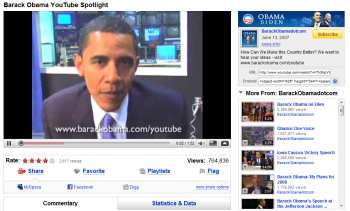Lately, there has been a trend for government agencies and elected officials to put their videos up on YouTube. While we commend them for doing so, we can’t help but wonder if this is, in the end, a positive trend. After all, while YouTube is definitely the most popular video sharing site, it is definitely not the only one. Yet, as we reported this morning, Congress is putting its videos on the site now, and President-elect Barack Obama is also making regular appearances on Google’s popular video sharing service.

In Obama’s defense, we have to say, though, that his team put his weekly “YouTube addresses” up on Yahoo and AOL as well, but the default still seems to be YouTube.
Why Shouldn’t They Use YouTube?
YouTube is not a public service but a commercial enterprise. Google might, one day, decided to just shut it down, and take its archive with it. One might argue that this is unlikely, but it could happen.
A stronger argument against favoring YouTube, however, is that it does look like preferential treatment of a service that is already close to being a monopoly. Given that services like TubeMogul make it incredibly easy to post videos to a large variety of online video services, there is really no excuse for government officials to only post videos to YouTube except for being ignorant about the alternatives.
As for the new Congresssites, even though this is a bipartisan effort, it would still be in the government’s best interest to avoid any appearance of a conflict of interest. Google after all is a major donor to the Obama campaign.

No Ads – But Lots of Status
Also, while Google doesn’t directly profit from these government videos (at least we haven’t seen any ads on these videos yet), it does turn YouTube into even more of a household name and extends its status as the de-facto video sharing site.
Host Videos In-House?
Congress and the White House probably have enough in-house technical know-how to host their own videos or put their videos on a white-label site. While we commend the members of Congress who put their own videos on YouTube, we would also like to see them use Vimeo, Viddler, blip.tv, and others.
On the other hand, though, YouTube is where the audience is, so putting videos on there makes perfect sense, but we would argue that it shouldn’t be the only place to find videos of our elected officials.





















